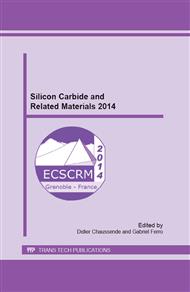[1]
K. Matocha and V. Tilak, Understanding the Inversion-Layer Properties of the 4H-SiC/SiO2 Interface, Mater. Sci. Forum, vol. 679–680, p.318–325, Mar. (2011).
DOI: 10.4028/www.scientific.net/msf.679-680.318
Google Scholar
[2]
D. B. Habersat, A. J. Lelis, and R. Green, Detection of Mobile Ions in the Presence of Charge Trapping in SiC MOS Devices, Mater. Sci. Forum, vol. 717–720, p.461–464, May (2012).
DOI: 10.4028/www.scientific.net/msf.717-720.461
Google Scholar
[3]
A. Chanthaphan, T. Hosoi, S. Mitani, Y. Nakano, T. Nakamura, T. Shimura, and H. Watanabe, Investigation of unusual mobile ion effects in thermally grown SiO2 on 4H-SiC(0001) at high temperatures, Appl. Phys. Lett., vol. 100, no. 25, p.252103–252103–4, Jun. (2012).
DOI: 10.1063/1.4729780
Google Scholar
[4]
A. J. Lelis, D. Habersat, R. Green, and N. Goldsman, Temperature-Dependence of SiC MOSFET Threshold-Voltage Instability, Mater. Sci. Forum, vol. 600–603, p.807–810, (2009).
DOI: 10.4028/www.scientific.net/msf.600-603.807
Google Scholar
[5]
D. B. Habersat, A. J. Lelis, and N. Goldsman, Simulating Ion Transport and its Effects in Silicon Carbide Power MOSFET Gate Oxides, in 2013 International Conference on Simulation of Semiconductor Processes and Devices (SISPAD), 2013, p.324–327.
DOI: 10.1109/sispad.2013.6650640
Google Scholar
[6]
A. J. Lelis, D. Habersat, R. Green, A. Ogunniyi, M. Gurfinkel, J. Suehle, and N. Goldsman, Time Dependence of Bias-Stress-Induced SiC MOSFET Threshold-Voltage Instability Measurements, Electron Devices IEEE Trans. On, vol. 55, no. 8, p.1835–1840, Aug. (2008).
DOI: 10.1109/ted.2008.926672
Google Scholar
[7]
S. Selberherr, Analysis and Simulation of Semiconductor Devices. [Mit Fig. ] - Wien 1983. 6, 2, 451 Bl. 4°. Springer-Verlag, (1984).
Google Scholar
[8]
G. Greeuw and J. F. Verwey, The mobility of Na+, Li+, and K+ ions in thermally grown SiO2 films, J. Appl. Phys., vol. 56, no. 8, p.2218–2224, (1984).
DOI: 10.1063/1.334256
Google Scholar
[9]
M. W. Hillen, G. Greeuw, and J. F. Verweij, On the mobility of potassium ions in SiO2, J. Appl. Phys., vol. 50, no. 7, p.4834–4837, Jul. (1979).
DOI: 10.1063/1.326547
Google Scholar
[10]
Y. Shacham‐Diamand, A. Dedhia, D. Hoffstetter, and W. G. Oldham, Copper Transport in Thermal SiO2, J. Electrochem. Soc., vol. 140, no. 8, p.2427–2432, Aug. (1993).
DOI: 10.1149/1.2220837
Google Scholar
[11]
E. I. Goldman, A. G. Zhdan, and G. V. Chucheva, Ion transport phenomena in oxide layer on the silicon surface and electron-ion exchange effects at the SiO2/Si interface, J. Appl. Phys., vol. 89, no. 1, p.130–145, (2001).
DOI: 10.1063/1.1327610
Google Scholar


